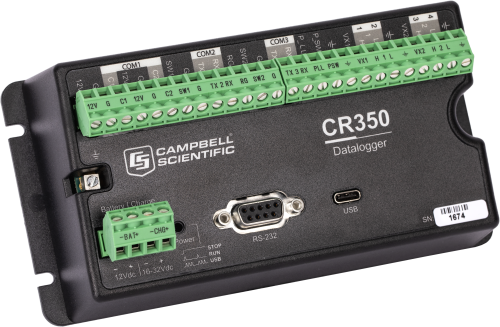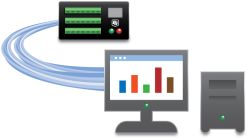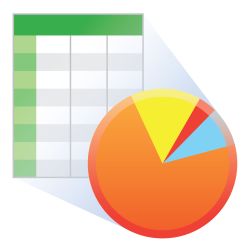
Ideal kleinere Projekte






Überblick
Der CR350 ist ein vielseitiger kompakter Datenlogger mit besonders geringem Stromverbrauch. Er kann dank seiner großen Befehlsbibliothek alle gängigen hydrologischen, meteorologischen, umwelttechnischen und industriellen Sensoren abfragen. Der CR350 verarbeitet die Daten und macht sie über verschiedene Netzwerke verfügbar in mehreren gängigen Protokollen. Auch M2M Kommunikation und Steuerungsfunktionen sind vorhanden. Dieser Datenlogger ist ideal für kleine Stationen die lange unabhängig und zuverlässig arbeiten sollen.
Im folgenden kurz die Unterschiede zwischen den CR300, CR310, and CR350 Datenloggern:
- Der CR310 und CR350 bieten abnehmbare Anschlussleisten.
- Der CR310 verfügt über einen 10/100 Ethernet Port.
- Der CR350 hat zwei unabhängige RS-232/RS-485 Ports und USB-C.
Den CR350 gibt es mit verschiedenen internen Kommunikationsoptionen, Wi-Fi, Mobilfunkt oder die folgenden Funkoptionen für verschiedene Regionen:
- CR350-RF407: US und Kanada
- CR350-RF412: Australien und Neu Seeland
- CR350-RF422: Europa
- CR350-RF427: Brasilien
Hinweis: Campbell Scientific empfiehlt den CR350 nicht als PakBus Router in Netzwerken mit mehr als 50 Geräten. Große Arrays oder String Variablen können auch für den Speicher zu viel sein. Für solche Anwendugen ist der CR1000X Measurement and Control Datalogger besser geeignet.
Lesen Sie mehrFunktionen und Vorteile
- Zwei spezielle SDI-12 Ports um weitere SDI-12-Senoren anschließen zu können
- Extrem geringer Stromverbrauch
- Zwei speziell RS-232/RS-485 Ports für digitale Sensoren oder Modems
- Einfaches Einrichten über PC Software und USB-C Verbindung
- Analoge und digitale Sensoren zuverlässig messen
- Bewährte Campbell Scientific- Qualität inklusive integrierter Überspannungs- und ESD- Schutz
- Integrated radio option to network wirelessly to another node or Internet gateway
- CR350-WIFI ideal for short-range, wireless IP communication
- Removable terminal block for easy wiring
- Ability to communicate anywhere using built-in cellular or satellite peripherals
- Integrierter Laderegler zum aufladen von 12V-Batterien über Solarzelle oder Netzteil
- Flexibility to connect with PakBus, Modbus, DNP3, GOES, and other standard communication protocols
- Multiple general-purpose I/O and programmability to analyze and control measurement acquisition
- Event-driven communications and physical outputs for notifications
Bilder

























Technische Beschreibung
The CR350 is a low-powered data logger designed to measure sensors, analyze data, and store data and programs. A battery-backed clock assures accurate timekeeping. The on-board, BASIC-like programming language—common to all Campbell Scientific data loggers—supports data processing and analysis routines.
Terminal Descriptions
- Two switched 12 V terminals (SW12V) for powering sensors or communication devices, 2100 mA
- Two sensor excitation or continuous 0.15 to 5 V terminals (VX1, VX2) for sensor excitation or output control
- Four multipurpose analog input terminals (SE1–SE4)
- Analog functions (SE1–SE4)
- Analog inputs: 4 single-ended or 2 differential inputs with -100 to +2500 mV and ±34 mV ranges 24 bit ADC
- 4 to 20 mA or 0 to 20 mA inputs (SE1, SE2 only)
- Digital I/O functions (SE1–SE4) consist of 3.3 V logic levels for:
- High frequency counter (35 kHz)
- Pulse width modulation
- Interrupts and timer input
- Period average (200 kHz, amplitude dependent)
- Analog functions (SE1–SE4)
- Two Pulse Counting Terminals (P_SW, P_LL)
- P_SW
- Switch closure (150 Hz)
- High frequency counter (35 kHz)
- P_LL
- Low level ac (20 kHz)
- High frequency counter (20 kHz)
- P_SW
- Two Control Terminals (C1, C2): C terminals are software configurable for digital functions
- Digital I/O functions consist of 5 V output and 3.3 V input logic levels for:
- SDI-12
- High frequency counter (3 kHz)
- Switch closure (150 Hz)
- General status/control voltage source 5 V; 10 mA @ 3.5 V
- Interrupts
- Serial asynchronous communication Tx/Rx pair
- Digital I/O functions consist of 5 V output and 3.3 V input logic levels for:
Kompatibel mit
Please note: The following shows notable compatibility information. It is not a comprehensive list of all compatible products.
Software
| Product | Compatible | Note |
|---|---|---|
| LNDB | Version 1.3 or higher | |
| LoggerLink | Version 1.5 or higher | |
| LoggerNet | Version 4.7 or higher | |
| LoggerNet Mobile Connect | Version 1.1 or higher | |
| RTDAQ | ||
| Short Cut | Version 4.4 or higher |
Miscellaneous
| Product | Compatible | Note |
|---|---|---|
| PC400 | Version 4.7 or higher |
Additional Compatibility Information
Sensors
With several channel types, the CR350 is compatible with nearly every available sensor. This includes analog output voltage (0 to 2.5 V) and current (0 to 20 mA or 4 to 20 mA) sensors, thermistors, and RTDs to name a few. It is also compatible with pulse or frequency output sensors such as anemometers, rain gauges, and flow meters. CR350 dataloggers are not capable of applying reverse excitation, and they cannot be used with some conductivity or soil matric potential sensors.
SDI-12, Modbus, and other serial sensors are supported with the RS-232 port and C1 and C2 as a Tx/Rx pair. The CR350 also supports true RS-232 and RS-485 on COM2 and COM3, along with a dedicated RS-232 DB9 port.
Measurement & Control Peripherals
The CR350 is compatible with low current and voltage solid-state relays but not with SDM or CDM devices.
Software
The CR350 series is compatible with CRBasic (version 3.6 or higher).
Enclosures
An ENC10/12 or ENC12/14 enclosure is adequate for most CR350-based systems.
Communications
The CR350 can communicate with a PC directly via its USB port. Compatible telemetry devices include our RS-485 converters, digital cellular gateways, RF telemetry, and satellite transmitters (HDR GOES, Argos, Meteosat, Iridium, and Inmarsat). Data can be viewed on an iOS or Android device (requires our free LoggerLink app), CD295 DataView II Display, or other third-party devices.
| Data Logger Option | Communications Type | Integrated Communications Are Compatible with |
|
CR350-WIFI |
2.4 GHz, 20 MHz bandwidth |
Most other Wi-Fi devices, such as the CR310-WIFI, CR300-WIFI, CR6-WIFI, NL240 |
|
CR350-RF407 |
902 to 928 MHz Frequency Hopping Spread Spectrum |
|
|
CR350-RF412 |
915 to 928 MHz Frequency Hopping Spread Spectrum |
|
|
CR350-RF422 |
868 MHz SRD860 LBT+AFA |
|
|
CR350-CELL |
2G Frequency Bands 850, 900, 1800, 1900 |
GSM/GPRS/EDGE (2G) |
Power
The CR350 uses an external power source and has a built-in charger/regulator. Intelligent power sourcing autoselects the highest voltage from three input sources (CHG, BAT, or USB) to operate in one of the following four modes:
- UPS (recommended) - A 16 to 32 Vdc source, solar panel (SP10, SP20), or power converter (29796) is used to charge a 12 Vdc battery, such as our BP7 or BP12.
- 12 Vdc battery or other reliable 12 Vdc source
- Charge only - DC power supply (16 to 32 Vdc)
- USB - Powered over 5 Vdc USB port for setup, programming, and testing (will not charge battery or boost USB power to provide 12 Vdc to the switched battery terminal SW12)
Spezifikationen
| Operating Temperature Range |
|
| Maximum Scan Rate | 10 Hz |
| Case Material | High-impact-resistant polycarbonate, recycle code 7 |
| Analog Inputs | 4 single-ended or 2 differential (individually configured) |
| Pulse Counters | 8 (P_SW, P_LL, C1, C2, and SE1 to SE4) |
| Voltage Excitation Terminals | 2 (VX1, VX2) |
| Communications Ports |
|
| Switched 12 Volt | 2 terminals |
| Digital I/O | 7 terminals (C1, C2, P_SW, and SE1 to SE4) configurable for digital input and output. Includes status high/low, pulse width modulation, external interrupt, and communication functions. Exception: C2 and P_SW don’t do pulse-width modulation. |
| Analog Input Limits | -100 to +2500 mV |
| Analog Voltage Accuracy |
|
| ADC | 24-bit |
| Charge Terminal Characteristics (CHG+ and CHG-) |
|
| Battery Terminal Characteristics (BAT+ and BAT-) |
|
| Internal Lithium Battery |
|
| Real-Time Clock Accuracy | ±3 min. per year |
| Internet Protocols | Ethernet, PPP, RNDIS, ICMP/Ping, Auto-IP(APIPA), IPv4, IPv6, UDP, TCP, TLS (v1.2), DNS, DHCP, SLAAC, NTP, Telnet, HTTP(S), FTP(S), SMTP/TLS, POP3/TLS, MQTT(S) |
| Communications Protocols | PakBus, PakBus Encryption, Modbus RTU/ASCII/TCP, DNP3, SDI-12, and others |
| CPU Drive/Programs | 50 MB serial flash |
| Data Storage | 50 MB serial flash |
| Idle Current Drain, Average | 0.5 mA (@ 12 Vdc) |
| Active Current Drain, Average |
|
| Dimensions |
16.3 x 8.4 x 5.6 cm (6.4 x 3.3 x 2.2 in.) Additional clearance required for cables and leads. |
| Weight | 288 to 306 g (0.64 to 0.68 lb) depending on communication option selected |
CR350-RF407 Option |
|
| Radio Type | Frequency Hopping Spread Spectrum (FHSS) |
| Output Power | 5 to 250 mW (user-selectable) |
| Frequency | 902 to 928 MHz (US, Canada) |
| RF Data Rate | 200 kbps |
| Receive Sensitivity | -101 dBm |
| Antenna Connector | RPSMA (External antenna required; see www.campbellsci.com/order/rf407 for Campbell Scientific antennas.) |
| Idle Current Drain, Average | 12 mA (@ 12 Vdc) |
| Active Current Drain, Average | < 80 mA (@ 12 Vdc) |
CR350-RF412 Option |
|
| Radio Type | Frequency Hopping Spread Spectrum (FHSS) |
| Output Power | 5 to 250 mW (user-selectable) |
| Frequency | 915 to 928 MHz (Australia, New Zealand) |
| RF Data Rate | 200 kbps |
| Receive Sensitivity | -101 dBm |
| Antenna Connector | RPSMA (External antenna required; see www.campbellsci.com/order/rf412 for Campbell Scientific antennas.) |
| Idle Current Drain, Average | 12 mA (@ 12 Vdc) |
| Active Current Drain, Average | < 80 mA (@ 12 Vdc) |
CR350-RF422 Option |
|
| Radio Type | 868 MHz SRD 860 with Listen Before Talk (LBT) and Automatic Frequency Agility (AFA) |
| Output Power | 2 to 25 mW (user-selectable) |
| Frequency | 863 to 870 MHz (European Union) |
| RF Data Rate | 10 kbps |
| Receive Sensitivity | -106 dBm |
| Antenna Connector | RPSMA (External antenna required; see www.campbellsci.com/order/rf422 for Campbell Scientific antennas.) |
| Idle Current Drain, Average | 9.5 mA |
| Active Current Drain, Average | 20 mA |
CR350-RF427 Option |
|
| Radio Type | Frequency Hopping Spread Spectrum (FHSS) |
| Output Power | 5 to 250 mW (user-selectable) |
| Frequency | 902 to 907.5 MHz/915 to 928 MHz (Brazil) |
| RF Data Rate | 200 kbps |
| Receive Sensitivity | –101 dBm |
| Antenna Connector | RPSMA (External antenna required) |
| Idle Current Drain, Average | 12 mA (@ 12 Vdc) |
| Active Current Drain, Average | < 80 mA (@ 12 Vdc) |
CR350-RF452 Option |
|
| Radio Type | Frequency Hopping Spread Spectrum (FHSS) |
| Output Power | 10 mW to 1,000 mW (user-selectable) |
| Frequency | 902 to 928 MHz |
| RF Data Rate | 115.2 or 153.6 kbps |
| Receive Sensitivity |
|
| Antenna Connector | RPSMA (External antenna required) |
| Idle Current Drain, Average | < 29 mA (maximum @ 12 Vdc) |
| Active Current Drain, Average | < 84 mA (maximum @ 12 Vdc) |
CR350-WIFI Option |
|
| Operational Modes | Client or Access Point |
| Operating Frequency | 2.4 GHz, 20 MHz bandwidth |
| Antenna Connector | Reverse Polarity SMA (RPSMA) |
| Antenna | pn 16005 unity gain (0 dBd), 1/2 wave whip, omnidirectional with articulating knuckle joint for vertical or horizontal orientation |
| Transmit Power | 7 to 18 dBm (5 to 63 mW) |
CR350-CELL205 Option |
|
| -NOTE- | The CR350-CELL205 option is not compatible with a Verizon cellular network. |
| Certifications | IC (Industry Canada) 10224A-201611EC21A |
| Cell Technologies |
|
| 3G Frequency Bands | 850, 1700/2100 (AWS), and 1900 |
| 4G Frequency Bands | 700, 850, 1700/2100 (AWS-1), 1900 |
| Antenna Connector | SMA (External antenna required; see www.campbellsci.com/order/cr350 for Campbell Scientific antennas.) |
| Power Consumption - Idle | 14 mA (average) |
| Power Consumption - Active | 75 mA (average) |
| SIM Interface |
3FF (6 position/contacts) Supports SIMs that require 1.8 or 3 V |
| Radio Output Power |
|
| Radio Sensitivity Range | -99.5 to 110.5 dBm (10 M) |
CR350-CELL210 Option |
|
| -NOTE- | The CR350-CELL210 option is only compatible with a Verizon cellular network. |
| Cell Technologies | 4G (LTE CAT-1) |
| 4G Frequency Bands | 700, 850, 1700, 1900, 2100 |
| Antenna Connector | SMA (External antenna required; see www.campbellsci.com/order/cr350 for Campbell Scientific antennas.) |
| Power Consumption - Low Power Mode | 5 mA |
| Power Consumption - Idle | 28 mA (average) |
| Power Consumption - Active | 90 mA (average) |
| SIM Interface |
3FF (6 position/contacts) Supports SIMs that require 1.8 or 3 V |
| Radio Output Power | 23 dBm on LTE |
| Radio Sensitivity Range | -99.5 to 110.5 dBm (10 M) |
CR350-CELL215 Option |
|
| -NOTE- | The CR350-CELL215 option is intended for use in EMEA countries. |
| Cell Technologies |
|
| 2G Frequency Bands | 900 and 1800 MHz |
| 3G Frequency Bands | 850, 900, and 2100 MHz |
| 4G Frequency Bands | 800, 850, 900, 1800, 2100, and 2600 MHz |
| Antenna Connector | SMA (External antenna required; see www.campbellsci.com/order/cr350 for Campbell Scientific antennas.) |
| Power Consumption - Idle | 14 mA (average) |
| Power Consumption - Active | 75 mA (average) |
| SIM Interface |
3FF (6 position/contacts) Supports SIMs that require 1.8 or 3 V |
| Radio Output Power |
|
| Radio Sensitivity Range | -99.5 to 110.5 dBm (10 M) |
CR350-CELL220 Option |
|
| -NOTE- | The CR350-CELL220 option is intended for use in Australia and New Zealand. |
| Cell Technologies |
|
| 3G Frequency Bands |
|
| 4G Frequency Bands |
|
| Antenna Connector | SMA (External antenna required; see www.campbellsci.com/order/cr350 for Campbell Scientific antennas.) |
| Power Consumption - Idle | 14 mA (average) |
| Power Consumption - Active | 75 mA (average) |
| SIM Interface |
3FF (6 position/contacts) Supports SIMs that require 1.8 or 3 V |
| Radio Output Power |
|
| Radio Sensitivity Range | -99.5 to 110.5 dBm (10 M) |
CR350-CELL225 Option |
|
| -NOTE- | The CR350-CELL225 option is intended for use in Japan. |
| Cell Technologies | 4G (LTE CAT-1) |
| 4G Frequency Bands | 800 (lower), 800 (upper), 850+, 900, 1800, and 2100 MHz |
| Antenna Connector | SMA (External antenna required; see www.campbellsci.com/order/cr350 for Campbell Scientific antennas.) |
| Power Consumption - Idle | 14 mA (average) |
| Power Consumption - Active | 75 mA (average) |
| SIM Interface |
3FF (6 position/contacts) Supports SIMs that require 1.8 or 3 V |
| Radio Output Power | 23 dBm on LTE |
| Radio Sensitivity Range | -99.5 to 110.5 dBm (10 M) |
CR350-CELL230 Option |
|
| Cell Technologies | LTE-Cat M, NB-IoT |
| Frequency Bands |
|
| Antenna Connector | SMA (External antenna required; see www.campbellsci.com/order/cr350 for Campbell Scientific antennas.) |
| Power Consumption - Idle | 23 mA average (26 mA if GPS is on) |
| Power Consumption - Active | 50 mA average (53 mA if GPS is on) |
| SIM Interface |
3FF (6 position/contacts) Supports SIMs that require 1.8 or 3 V |
Dokumente
Broschüren Produkte
Technische Artikel
Videos & Tutorials
Downloads
CR350 OS v.01.07 (5.30 MB) 06-02-2025
This download is for the CR350 datalogger. Execution of this download places the Operating System file(.obj) on your computer. It also updates the CRBasic Editor compiler and support files.
Why Update? This OS adds Campbell Cloud compatibility enhancements and resolves bugs found in the previous OS. See the revision history for a complete list. With this OS update, it is recommended that you also update the Device Configuration Utility to the most recent version so that new datalogger features are available in the utility.
Note/Warning: Campbell Scientific always recommends updating operating systems on site if possible. When remote updates are required, it is recommended that you implement the necessary precautions to handle unexpected OS upload complications. All datalogger settings should be retained when updated remotely. If you choose to roll back to a previous operating system, the datalogger settings will be reset to default.
Watch the Video Tutorial: Sending an OS to a Local Datalogger.
Data Logger Wiring Excel Template (1 KB) 26-03-2024
This is a data logger wiring diagram spreadsheet template that accompanies the Wiring Diagram Video. The spreadsheet includes templates for CR6, CR1000X, CR300, CR310, and CR350 data loggers. The file is an Excel template and works best with Microsoft Excel.
FAQs für
Number of FAQs related to CR350: 1

































